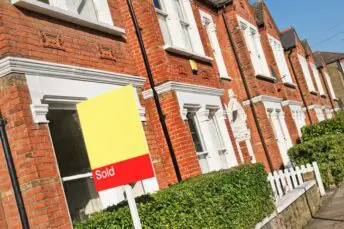House Price Watch July 2023
House prices and transactions remained fairly stable over the past month. However, buyer demand continues to fall and more sellers are accepting below asking price offers to achieve a sale. Larger, more expensive properties are seeing the greatest fall in sales activity and prices. Looking ahead, activity is expected to remain constrained and house prices are likely to continue to fall whilst mortgage rates remain elevated.
What’s happening nationally
House prices increased slightly this past month (+0.1%) but are down on average -1.5% in the past year.
Land Registry reporting June figures noted a slight increase in house prices over the past month, while the other indices reporting July figures recorded a slight fall in house prices. All the indices indicate a slowing of the annual rate of growth with Nationwide and Halifax showing a continued fall in house prices over the past year.
Indices based on:
Land Registry – registered property transactions in June.
Nationwide & Halifax – mortgage valuations in July.
Rightmove – asking prices posted on Rightmove in July.
*Rightmove is not included in the index average as the basis for its index is different (asking price vs agreed sale price)
| Index reports: | Monthly change | Annual change |
|---|---|---|
| Land registry | +0.7% | +1.7% |
| Nationwide | -0.2% | -3.8% |
| Halifax | -0.3% | -2.4% |
| Rightmove | -0.2% | +0.5% |
| Average change | +0.1% | -1.5% |
House prices in your area
Most areas show an increase in house prices over the past month. The annual rate of house price growth continues to slow and is in negative territory in London (-0.6%).
Still, average house prices are highest in London (£528K) and lowest in the North East (£161K).
| UK Region | Average price £ | Monthly change | Annual change |
|---|---|---|---|
| England | |||
| Nothern Ireland | |||
| Scotland | |||
| Wales | |||
| North West | |||
| Yorkshire and The Humber | |||
| North East | |||
| West Midlands | |||
| East Midlands | |||
| South West | |||
| East of England | |||
| South East | |||
| London |
| UK City | Average price | Annual change |
|---|---|---|
Market Monitor
There were 86K transactions in June, up 6% on May 2023, 15% lower than June 2022. 86K transactions is amongst the lowest we have seen in the last decade.
Demand continues to fall as do new instructions from sellers this month. Average stock per agent is up month on month. Rightmove, Zoopla and Halifax all report greater activity among First Time Buyers looking for smaller properties, with less demand for more expensive family properties.
Time to sell is steady at approximately 55 days, slower than the average of 48 days over the last 12 months.
How busy is the market?
- Not busy
- Normal
- Very busy
- Transactions up in June, but remain at ten year low
- Total transactions in June 86K
- +6% from last month
- -15% from May last year
Homes for sale vs homebuyers
- Good availability of homes
- Normal
- Shortage of homes
- Buyer enquiries continue to fall(-45% RICS); another sharp downturn in demand
- Seller enquiries down (-13% RICS)
- Average stock per agent 52; up from 49 last month (incl under offer/ Sold STC Rightmove)
Average speed of sale
- Fast
- Normal
- Slow
- 55 days to find a buyer, steady (12 month average 48 days Rightmove)
What the experts say
Rightmove - agent's view

“The interest-rate brakes being applied more strongly to slow the economy are now beginning to bite in the housing market. While prices and sales bounced back this year much more strongly than most expected, the unexpectedly stubborn inflation figures and the surprise of further mortgage rate rises when many felt that they had stabilised, have contributed to the fall in prices and number of sales agreed. However, buyer demand remains resilient at 3% above 2019’s more normal market levels, buoyed by a shortage of quality property for sale and ongoing housing needs. First-time buyers, trader-uppers and downsizers with higher deposits and lower mortgage requirements appear to be still keenly searching the market, not wanting to miss out on the right property that is not over-priced and that they can still afford.”
Nationwide

“There was a slight fall of 0.2% over the month. As a result, the price of a typical home is now 4.5% below the August 2022 peak. Investors’ views about the likely path of UK interest rates have been volatile in recent months, with the projected Bank Rate peak fluctuating between 5% in mid-May and 6.5% in early July. There has been a slight tempering of expectations in recent weeks but longer-term interest rates, which underpin mortgage pricing, remain elevated. As a result, housing affordability remains stretched for those looking to buy a home with a mortgage. A prospective buyer, earning the average wage and looking to buy the typical first-time buyer property with a 20% deposit, would see monthly mortgage payments account for 43% of their take home pay (assuming a 6% mortgage rate). This is up from 32% a year ago and well above the long-run average of 29%. This challenging affordability picture helps to explain why housing market activity has been subdued in recent months.”
Halifax

“Average UK house prices edged down slightly in July. While this was the fourth consecutive monthly decrease, prices are little changed over the last six months. The housing market continues to display a degree of resilience in the face of tough economic headwinds. In particular, activity amongst first-time buyers is holding up relatively well, with indications some are now searching for smaller homes, to offset higher borrowing costs. Conversely the buy-to-let sector appears to be under some pressure, though elevated interest rates are just one factor impacting landlords’ business models, together with considerations of future rental market reforms. Expectations of further Base Rate increases from the Bank of England were tempered by a better-than expected inflation report for June. However, while there have been recent signs of borrowing costs stabilising or even falling, they will likely remain much higher than homeowners have become used to over the last decade. The continued affordability squeeze will mean constrained market activity persists, and we expect house prices to continue to fall into next year.”
Zoopla (Hometrack)

“Higher mortgage rates have hit home buyer demand, but the impact is not uniform across the country. Southern England is set to experience above average price falls. Drilling below the regional level, it’s clear that housing markets with average prices over £300,000 are feeling the impact of higher mortgage rates – 80% of markets with an average price over £300K are registering annual price falls. There is an above average proportion of sellers cutting asking prices with 6.5% of homes for sale seeing >5% cuts to asking prices; a clear sign that buyers have become more price sensitive over the last 2 months. There is a shift in the mix of homes selling towards smaller homes. Comparing trends in the last 4 weeks to the same period over the last 5 years we find that agreed sales of family homes are down by up to 41%. Sales of smaller homes and flats have fallen to a lesser degree.”
RICS

“The July 2023 RICS UK Residential Survey results are symptomatic of a market losing further ground in the face of higher mortgage rates. Indeed, indicators tracking activity continue to exhibit firmly negative readings, while widespread falls in house prices are being reported. Moreover, respondents foresee this picture remaining in place over the near-term, with sales expectations turning a little more pessimistic during the latest survey period.”




